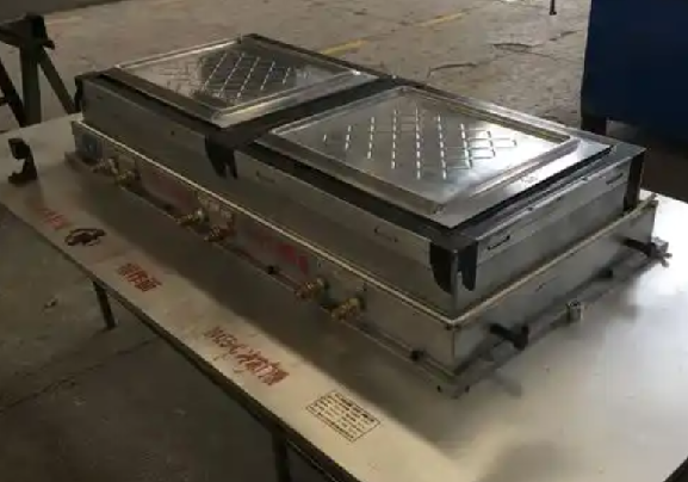Views: 0 Author: Site Editor Publish Time: 2025-07-18 Origin: Site
The stamping die technology for dishwashers' Stainless Steel Tub is a critical process in home appliance manufacturing, with its technical level directly impacting the forming accuracy, production efficiency, and product quality of the stainless steel tub. The following provides a detailed analysis from the perspectives of inner tank structural characteristics, die design key points, manufacturing processes, and material selection.

■Stamping Structure and Material Properties of Dishwasher Stainless Steel Tub
(1)Stainless Steel Tub Structural Characteristics
Complex Curved Surface Design: To fit the internal space of dishwashers, inner tanks often include rounded corners, grooves, reinforcing ribs, and other structures, requiring precise die forming.
Sealing and Corrosion Resistance Requirements: Minimal weld seams, high surface finish (Ra ≤ 1.6μm) to prevent detergent residue and rust.
Dimensional Accuracy: Typical tolerance requirement ±0.3mm, critical assembly hole tolerance ±0.1mm.
(2)Common Materials
| Types | Applications |
| 304 Stainless Steel | suitable for humid environments, moderate cost |
| 430 Stainless Steel | Magnetic stainless steel, high strength, used in non-water-contact areas |
| Alvanized Steel (SECC) | Low cost, requires additional anti-corrosion coatings |
■Key technical points of the Stamping die
CAD/CAM Digital Design: Utilize UG software for 3D modeling, combined with DFM (Design for Manufacturing) analysis to optimize die structure.
Stamping Process Simulation: Use AutoForm software to simulate drawing and bending processes, predicting defects such as cracking and wrinkling.
Die Structure Design
Single-operation Dies: Suitable for simple processes (e.g., punching, trimming); low cost but less efficient.
Compound Dies: Integrate multiple operations in one die (e.g., blanking + drawing), ideal for small-to-medium batch production.
Progressive Dies (Continuous Dies): Automated feeding with multi-station continuous stamping; high efficiency, suitable for mass production (e.g., continuous stamping of inner tank side panels).
Key Design Parameters
Punch-Die Clearance: Typically 1.1–1.2 times material thickness for stainless steel drawing dies to avoid material scratching.
Corner Radius: Die corner radius is generally 5–10mm; too small may cause cracking, while too large affects forming accuracy.
Ejection Mechanism: Elastic ejectors (e.g., nitrogen springs) prevent workpiece sticking.

(2) Stamping Die Manufacturing Processes
Machining Technologies
CNC Machining: Used for high-precision milling of die cores and cavities, achieving ±0.02mm accuracy.
EDM (Electrical Discharge Machining): Processes complex curved surfaces (e.g., rounded corners, reinforcing ribs) with surface roughness Ra ≤0.8μm.
WEDM (Wire EDM): For machining die cutting edges and small holes, with ±0.01mm precision.
Heat Treatment Processes
Quenching + Tempering: Die steel (e.g., Cr12MoV) undergoes 1020°C quenching + 200°C tempering to reach HRC 58–62 hardness, enhancing wear resistance.
Surface Hardening Treatments
Nitriding: Nitrogen atoms penetrate the surface to form a hardened layer (0.1–0.3mm depth), achieving HRC 65–70 hardness; ideal for drawing dies.
PVD Coating: Deposits TiN or TiCN coatings (1–3μm thickness), reducing the friction coefficient and extending die lifespan by 3–5 times.
(3) Stamping Die Material Selection
| Material Type | Representative Grades | Hardness | Characteristics & Applications |
| Alloy Tool Steel | Cr12MoV | D2 HRC58~62 Excellent wear resistance | Used for punching/drawing dies |
| High-Speed Steel | SKH-9 | M2 HRC 62–65 Heat-resistant | Suitable for high-speed stamping (>200 strokes/min) |
| Cemented Carbide | YG15 | DC53 HRA 85–90 Ultra-wear-resistant | High-volume production cutting inserts |
| Pre-Hardened Steel | S136 | NAK80 HRC 35–45, Corrosion-resistant | Dies are exposed to corrosive materials |
(4) Advanced Stamping Die Technology Applications
| Intelligent Die Technology | Stamping Die Condition Monitoring: Embedded sensors (pressure/temperature/displacement) enable real-time stamping process monitoring to prevent die damage |
| Green Manufacturing Technology | Dry Machining: Utilizes ceramic tools or MQL (Minimum Quantity Lubrication) to minimize cutting fluid pollution |
Die Remanufacturing: Worn dies repaired via laser cladding achieve a 50% reuse rate improvement |
■ Typical Stamping Die Process Challenges & Solutions
| Issues | Causes | Solutions |
| Drawing Cracking | Uneven material flow, insufficient die corner radius | 1. Optimize drawing coefficient (≤0.7); implement multi-stage drawing. 2. Apply hard chrome plating (5–10μm) to die surfaces to reduce friction. 3. Adopt hydraulic presses for controllable blankholder force. |
| Dimensional Instability | Die wear, stamping temperature fluctuations | Use cemented carbide inserts for critical areas (e.g., cutting edges, guide pillars) |
| Surface Scratching | The die stamping process collision | 1.Polish die surfaces to Ra≤0.4μm with edge rounding (R0.2mm). 2. Apply PE film or graphite lubricant to minimize material-die friction. |

■ Stamping Die Quality Control & Inspection
Die Inspection:
CMM Measurement: Inspects die surface contours with ±0.01mm accuracy.
Blue Light Scanning: Rapidly captures 3D mold data and compares with design models (deviation ≤0.05mm).
Stamiped Part Inspection:
Visual Inspection: Checks for surface scratches/deformation (defect threshold ≤0.1mm).
Functional Testing:
Water holding test (24-hour leakage-free) for inner tanks.
Pressure resistance test (0.2MPa).
■ Industry Case Study: Die Optimization for a Brand Dishwasher
| Issue | The original die had low production efficiency (50 pcs/hour) with a 15% drawing cracking rate |
| Solutions | Adopted a progressive die design with added pre-drawing, reducing the drawing coefficient from 0.65 to 0.58 (implemented in 2 stages). Applied DC53 cemented carbide + TiAlN coating to the die cavity, extending service life from 50,000 to 150,000 cycles. |
| Results | Production efficiency increased to 120 pcs/hour, Cracking rate reduced to 3% ,Stamping die costs lowered by 20% |
■ Conclusion
Stamping die technology for dishwasher inner tanks must balance structural precision, corrosion resistance, and production efficiency. Competitiveness is enhanced through digital design, precision machining, and material innovation. Moving forward, intelligentization and green manufacturing will emerge as core development drivers, accelerating the transformation of home appliance manufacturing toward high-quality standards.

content is empty!
content is empty!
ZHUHAI GREE DAIKIN PRECISION MOLD CO., LTD.